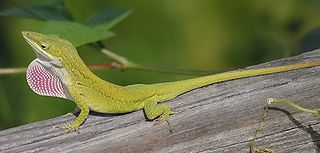There are two species of lizard named ghost anole:
- Anolis lemurinus , found in Central and South America
- Anolis spectrum , found in Cuba
There are two species of lizard named ghost anole:

Dactyloidae are a family of lizards commonly known as anoles and native to warmer parts of the Americas, ranging from southeastern United States to Paraguay. Instead of treating it as a family, some authorities prefer to treat it as a subfamily, Dactyloidae, of the family Iguanidae. In the past they were included in the family Polychrotidae together with Polychrus, but the latter genus is not closely related to the true anoles.

The brown anole, also known commonly as the Cuban brown anole, or De la Sagra's anole, is a species of lizard in the family Dactyloidae. The species is native to Cuba and the Bahamas. It has been widely introduced elsewhere, via the importation and exportation of plants where the anole would lay eggs in the soil of the pots, and is now found in Florida and as far north in the United States as southern Georgia, Texas, Louisiana, Mississippi, Alabama, Hawaii, and Southern California. It has also been introduced to other Caribbean islands, Mexico and Taiwan in Asia.
Cuban anole may refer to:
A. occultus may refer to:
A. vanzolinii may refer to:
There are two species of lizard named neotropical green anole:
Roquet may refer to:
There are three species of lizard named Hispaniolan green anole:
A. bartschi may refer to:
There are two species of anole named slender anole:
Anolbanolis is an extinct genus of iguanian lizards that lived in the Bighorn Basin of what is now Wyoming during the earliest Eocene. The type species A. banalis was named by paleontologist Krister Smith in 2009 from a collection of isolated skull fragments found in a layer of the Willwood Formation that dates to a brief period of global warming called the Paleocene-Eocene thermal maximum (PETM) about 56 million years ago. The genus name Anolbanolis means "poor anole" from the Greek anolbos and the name Anolis, in reference to the scrappy nature of known fossil material and its close resemblance to lizards in the genus Anolis. Smith suggested that Anolbanolis may be a close relative of Anolis or Polychrus, which are common today in Central and South America but not found as far north as Wyoming, fitting with the idea that the Bighorn Basin was warmer and wetter in the Eocene than it is currently. According to Smith, the species name banalis is a reference to it being a "banal" lizard in the Willwood, being "quite abundant in the type locality," and not unusual because "the discovery of Eocene boreal fossil members of living subtropical and tropical clades is becoming commonplace." In 2011 Smith named a second species of Anolbanolis, A. geminus, which lived in the Bighorn Basin shortly after the PETM and was about 50 percent larger than A. banalis. Smith concluded on the basis of features in A. geminus that Anolbanolis is more closely related to Anolis than it is to Polychrus.
There are two species of lizard named panther anole:
There are four species of lizard named bark anole:
There are two species of lizard named giant green anole:
There are three species of lizard named Hispaniolan gracile anole:
There are two species of bird named goldenscale anole:
There are two species of lizard found in the Dominican Republic named Northern Hispaniolan green anole:
There are two species of lizard named copper anole:
There are two species of lizard named banded anole:
There are two species of lizard named spotted anole: